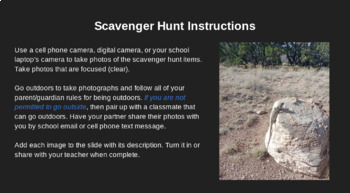Science Outdoor Scavenger Hunt (online learning grades 6-8)
- Google Slides™

Description
Save your own copy of this scavenger hunt slide show and post a copy for each student in Google Classroom. Students read the clues, search for items outdoors, take photos, then add their images to the slide show. This activity provides a break from online learning and gets students outdoors. Students interpret the clues and get creative with photography.
Students may work alone, in pairs, or in small groups. Make a challenge to find 10 of 15 items or all 15! Students follow the clues to find sedimentary, igneous, and metamorphic rocks, soil, liquid water, examples of different kinds of energy, photosynthesis, insects and pollinators, sunlight, and a photo of a student scientist.
Instructions (comprehensive instructions included in the slide show): Use a cell phone camera, digital camera, or your school laptop’s camera to take photos of the scavenger hunt items. Go outdoors to take photographs and follow all of your parent/guardian rules for being outdoors. If you are not permitted to go outside, then pair up with a classmate that can go outdoors.


